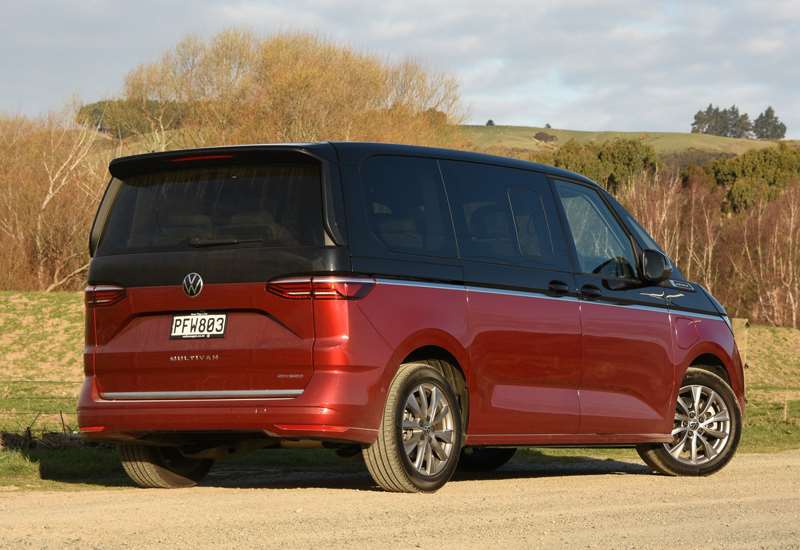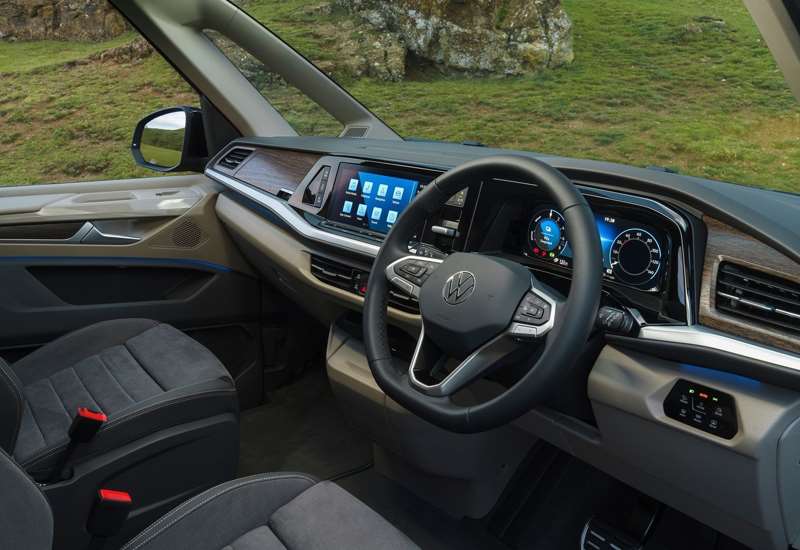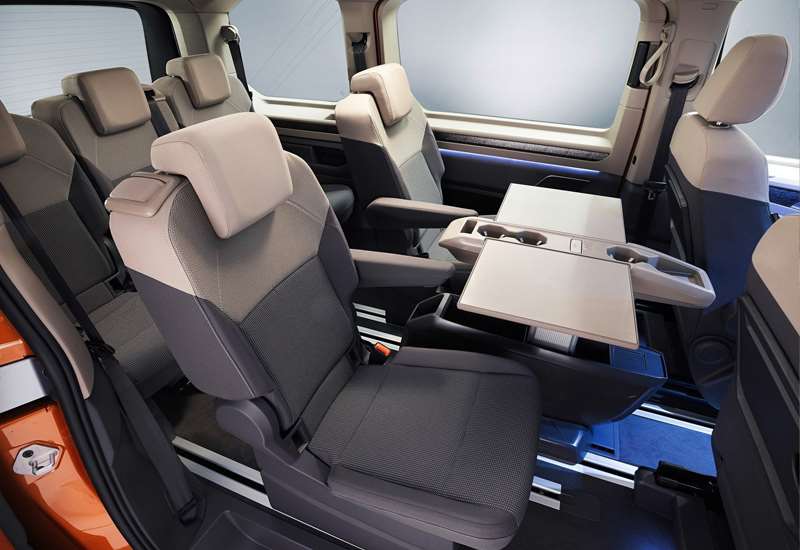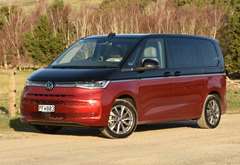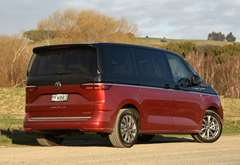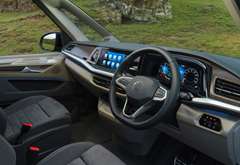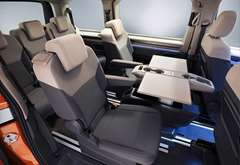A plug-in hybrid option has been added to Volkswagen’s passenger van line, and David Thomson has been spending time behind the wheel.
What’s new?
When it comes to innovation in the world of passenger vans, Volkswagen has an unrivalled pedigree, dating back to the beloved Kombi of hippie-era fame.
That original Volkswagen van (later referred to as the T1) was produced in Germany until 1967, and then in Brazil through to the 1970s. The distinctive rear-engine configuration it was known for was shared by its successors, the T2 and T3. Only in 1990, with the T4, did Volkswagen move to a front-engine layout.
The T5 model appeared in 2003, followed in 2016 by the T6 which used the same underlying platform with major revisions to both the exterior and interior. Then, in 2019, the model was refreshed again to become the T6.1.
Now the T7 Multivan has landed. It is a completely fresh start, being built around the MBQ platform used by regular VW passenger cars and introducing hybrid technology to VW’s passenger van line for the first time.
The brief for this new arrival is an interesting one. Well into next year at least, it won’t be so much a replacement for the T6 Multivan, as a companion model. Longer-term, though, it will completely replace the T6 in the passenger van stakes. Globally, it’s also expected to displace VW’s two more conventional people movers, the Touran and Sharan.
Comparing the T6.1 and T7, the most obvious point of difference is the powertrain. All variants of the T6.1 are propelled by a 2.0-litre 110kW/ 340Nm 4-cylinder turbo-diesel engine, with two versions also featuring four-wheel-drive.
New Zealand doesn’t yet see a turbo-diesel T7. Instead, all three variants currently offered feature a plug-in hybrid set-up that combines a 1.4-litre turbo-petrol engine with an electric motor and a 13kWh battery pack. The combined peak outputs of the system are 160kW and 350Nm, it’s front-drive only, and the notional range under battery power alone is 50km.
Both T6.1 and T7 Multivans are configured as seven-seaters, the new arrival being 70mm longer, but 633mm lower and 45mm narrower.
Pricing for the T7 opens at $78,990 for the Family variant, while the Life version lists at $96,500 and the flagship Energetic (as tested) at $106,000. Slipping in under the $80k threshold, the T7 Multivan Family secures a $5750 clean car rebate, while the Life and Energetic are zero-rated under the current scheme.
What comes as standard?
Volkswagen has done well to land the base-model T7 Multivan Family as a sub-$80,000 machine, but it has meant sacrifices in standard equipment for the base model. Most obviously, it misses out on the adaptive radar cruise control, two-tone paint finish, and some (but not all) of the active safely items that feature further up the range.
That said, the Family is still fairly well equipped. Its safety package includes lane-keeping assist, forward-collision assist, autonomous emergency braking, a rearview camera, park-distance control, driver-attention alert and tyre-pressure monitoring. There is keyless entry and push-button start, power-operated side doors, LED head and tail lights, dual zone climate control, 10-inch infotainment screen, a fully digital main instrument cluster, and a sliding multifunction centre console.
The Life variant adds the two-tone paint option, adaptive cruise control, side and rear cross-traffic alert, an enhanced lighting package, tri-zone climate control, and an improved seating package that includes armrests for the second seating row and front-seat heaters.
The flagship Energetic gets parking assist, a power-opening tailgate, panorama sunroof, ErgoComfort front seats with a massage function, and easy opening (just swish a foot under it) for the side doors and tailgate.
What does it look like?
There are reasonable grounds for VW’s claim that the Multivan T7 is a serious alternative to a three-row, seven-seater SUV, but it’s also fair to say that when judged in this context, styling is not a point in the Multivan’s favour.
On the plus side, the T7 is reasonably smooth-lined by van standards, and certainly much fresher in appearance than the T6. The wrap-around front lights are quite futuristic, and the two-tone paint (separated by a chrome strip) added interest to the test vehicle.
The test car didn’t exactly flaunt its plug-in hybrid status; there’s a small ehybrid badge on the tailgate, and the flap to access the charge port is positioned just forward of the driver’s door. Both the Life and Energetic variants step up from the 17-inch alloys of the entry-level model to sit on 18-inch alloys shod with 235/50 tyres.
What’s it like inside?
A square, boxy shape pays dividends when it comes to interior space. Volkswagen has also endowed the T7 Multivan with clever passenger-carrying flexibility: all of the middle and rear-row seats are individually mounted on rails for adjustability, seats can be removed, and the middle seats can even be turned around to face the rear pair. Drawers are also included under the outer seats, and there are quad rear USB-C plugs.
Power-operated sliding doors ensure easy access to the middle and back rows of the cabin, and while the floor is high, there is a useful step and some grab-handles to assist with egress.
The front seats are normally separated by a height-adjustable centre console, but that too is mounted on rails so it can be repositioned further aft in the cabin if desired. The console even includes a pair of pop-up trays that can be deployed airline-style for the rear seats and are sturdy enough for a laptop or tablet device.
Being the flagship variant, the test car was equipped as standard with the premium front seats. These armchair style pews are comfortable and supportive, and the seating position affords a commanding view.
The dash look and layout is clean and contemporary, with the large centre touchscreen and fully-digital main instrument cluster separated by the dash-mounted toggle-style gear selector. A handy phone tray with dual USB-C plugs sits below the centre screen and air vents, and beneath the tray there is a flip-down cup and bottle holder. There is a handy double-glovebox arrangement too, and decent door bins.
The combination of light upper-trim surfaces, double sunroof and generous windows enables a bright and airy ambience during the day, while at night there is the choice of 30 different shades for the interior LED lighting.
Amid a plethora of positives in the look and configuration of the test car, the choice of hard-touch surfacing on the dash and doors was disappointing; OK, the T7 is a van, but in flagship guise it is a van with a $100,000-plus price tag.
On the other hand, the digital instrumentation and infotainment system are not in the least van-like, being same set-up as found on contemporary Volkswagen passenger cars.
What’s it like to drive?
The arrival by air of out-of-town guests provided a great chance to put the Multivan T7 through its paces with all three seating rows occupied, via a couple of airport runs, some more general open-road driving and round-town motoring.
From a passenger perspective, the spacious and comfortable seating and good visibility from the bright, airy cabin was much appreciated. The third-row seating is notably superior to that offered by a conventional seven-seatere SUV. So too is luggage capacity at a decent 460 litres with all three seats deployed, 1800 litres plus with the rear seats removed and more than 3600-litres with just the front seats in place. Round-town motoring under electric power alone is commendably hushed, and both the sound system and air-conditioning are effective across all three seating rows. Urban ride quality is generally good, though the rear of the vehicle kicked up uncomfortably while mounting the worst of the many speed humps plaguing Dunedin roads. Open-road motoring is not as refined, for when the petrol engine comes into play it generates mechanical noise. Coarse-chip road rumble is also quite intrusive, especially towards the rear of the cabin.
From the driver’s seat, the T7 is a pleasant enough vehicle to pilot. While an undeniably large and heavy (2.2-tonnes) machine, its controls are light, and the combination of a commanding driving position and camera systems make it an easier prospect around city streets than you might expect.
Range under battery power alone is rated at 50km, but 30km is nearer the mark of what was achievable navigating Dunedin’s streets and topography. For many people, that capacity will be enough to manage the daily commute fossil fuel-free. Where that’s not the case, the petrol engine will deploy as necessary.
Most owners will likely stick with the default drive mode in which the vehicle itself determines when to run on battery power alone and when to deploy the petrol engine. However it’s also possible to manually select the fully electric mode, or hybrid mode, and to set the system up so that the petrol engine is not only powering the vehicle, but recharging the battery to a driver-determined level as well.
Performance is entirely adequate for a vehicle of this type, with power delivery to the front wheels via the six-speed DSG transmission smooth and linear.
Adopting a car-based platform for the T7 Multivan delivers a marked improvement in handling compared to the T6 model. Though it’s in no sense the kind of vehicle to checked through twists and turns, it handles with a dignified predictability, and none of the uncomfortable lurching that can be a feature of passenger vans based-off light-commercial platforms.
The official standard cycle economy figure T7 Multivan is just 1.1l/100km, but that’s only ever going to be achievable for those people who drive almost entirely around town in short hops that make full use of the vehicle’s battery-only range. Drivesouth managed 4.9l/100km on a mix of urban and highway driving; and while this result is a long way shy of the official standard cycle figure, that’s still a good return for a large seven-seater minivan.
Verdict
The Multivan 7 is a great step forward for Volkswagen, as one would expect given that the outgoing T6 is based on a platform close to 20 years old. In launching the new model here with a plug-in hybrid powertrain, VW is moving with the times, though the diesel option expected next year will also be appealing in this part of the country.

